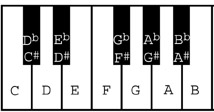 4 BASIC CHORDS
4 BASIC CHORDS
There are basically four chord types in piano music: major, minor, diminished and augmented.
Although they sound completely different from one another, all four are built from the same harmonic material:
major thirds and minor thirds. Before we explore how to build these chords, let's learn how to create the intervals
from which they are built. We'll use the keyboard as a visual aid.
To a non-player the keyboard may look confusing, but the layout is quite simple: each key, black or white, is a half-step apart from its neighbor. For example: the C key is a half-step away from the C# key. The E key is a half step away from the F key. The E key is also a half-step away from the Eb key (E flat). Why a half-step? It's just a name. A half-step is the smallest difference between two pitches our Western culture ears can perceive. Music from other cultures (Japan, Bali, India) divide pitches by quarter-tones and other interesting divisions. Here in America we use the half-step. Think of the piano as a collection of all the musical pitches we can hear.
So far so good.? But how far apart are the notes in major thirds and minor thirds?
The notes of a major third (M3) interval are separated by two whole steps. C to E is a major third interval. Check this out on the keyboard: C to D is a whole step, and D to E is a whole step, so C to E must be two whole steps. Nothing to it!
The notes of a minor third (m3) interval are separated by one-and-a-half steps. C to Eb is a minor third. The reason is simple; C to D is a whole step, D to Eb is a half step, therefore C to Eb must be one-and-a-half steps.
Now we know how to find and build major thirds and minor thirds. Using just these two intervals we can build the four basic chords of Western music.
Here are the four formulas, one for each chord type (note: M3=major third, m3=minor third):
M3 +m3=Major chord
m3+M3=Minor chord
m3+m3=Diminished chord
M3+M3=Augmented chord
m3+M3=Minor chord
m3+m3=Diminished chord
M3+M3=Augmented chord
Let's build one of each, using C as our tonic or root note.
Take our first example, a major chord. C to E is a major third (M3). Therefore, these are the first two notes of
a C major triad. We need another note a minor third above the E. G is a minor third above E (check this out on
the keyboard). There's our C major triad: C-E-G.
Using the minor chord formula above, let's build a C minor (Cm). First we need a minor third interval: C to Eb.
Now we need a major third interval starting on the Eb: G is a major third above Eb (check this out on the keyboard).
There's our C minor (Cm) triad: C-Eb-G.
A diminished chord consists of one minor third stacked on top of another. C to Eb is a minor third, and Eb to Gb
is also a minor third. Voila! Our C diminished chord (C°): C-Eb-Gb.
Which pair of thirds have we not yet used? A pair of major thirds. C to E is a major third, E to G# is also a major
third. And there we have it, folks: a C augmented chord (C+): C-E-G#.
Remembering these four chord formulas is simple. Major chords start with a major third (M3) followed by a
minor third (m3), minor chords start with a minor third (m3) followed by a major third (M3). Diminished
chords can be thought of as minor chords that are even more minor (diminished means made smaller) so they have
two minor thirds (m3+m3). Augmented chords can be considered major chords that are even more major
(augmented means added to) so they have two major thirds (M3+M3). Memorize these combinations of thirds
and you'll instantly know how to build FORTY-EIGHT chords, starting on any note.
